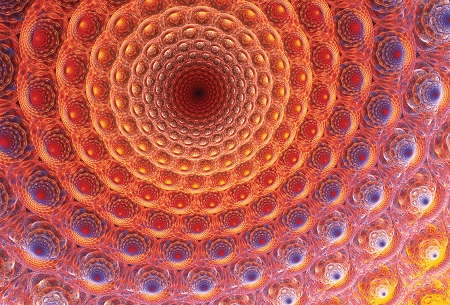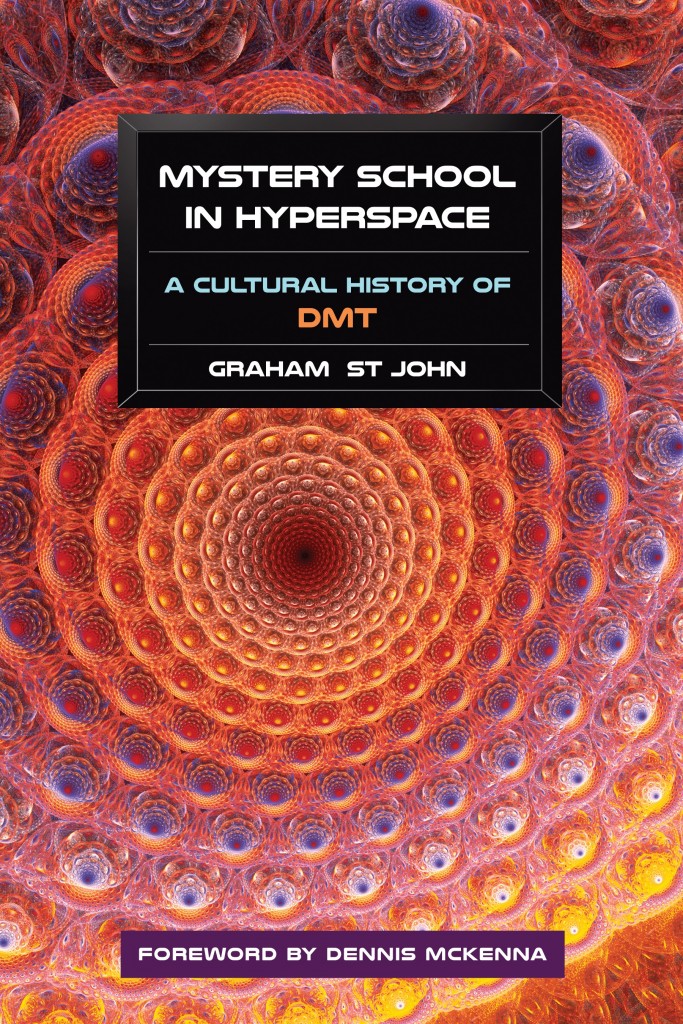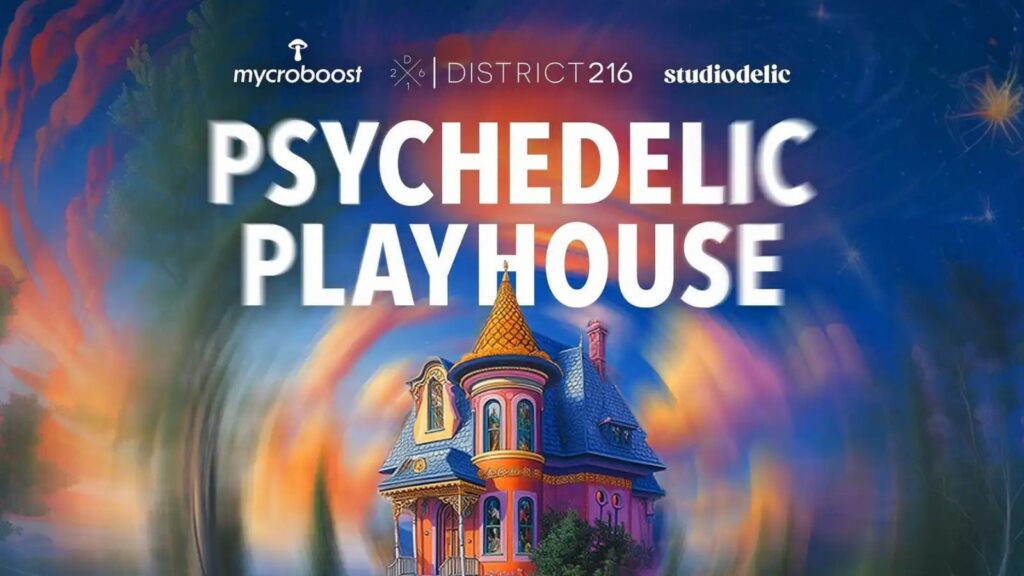Erik Davis interviews Graham St John about his new book on DMT, Mystery School in Hyperspace: A Cultural History of DMT (Evolver/North Atlantic Books, 2015).
Erik Davis: Your book is the first thorough cultural history of DMT. We already have similar accounts of ketamine, MDMA, LSD, and mushrooms. Was there a kind of force field around the drug that kept it away from historical and cultural writers like yourself?
Graham St John: I guess it’s the same force field that prevents the mystery from being exposed. Spoiler alert: this book does not reveal the mystery once and for all, although it does attempt to shed light on the nature of mystery and its laws of attraction. In any case, this gap in the literature on survivors of the War on Drugs to which you allude is quite telling.
What it seemed to be telling me was that DMT possesses a unique mystique. It has been, and remains, an enigma, a status well earned due to its profound effects, but also because of the manifold hats this compound has worn since the discovery of its psychopharmacological actions in the mid 1950s, and subsequent to that its endogenous status to humans. The contemporary science on DMT is labyrinthine. This is a most complex and contested phenomenon, that has, for instance, been damned as the “nightmare hallucinogen” with no medicinal value, or received accolades as the “spirit molecule”, and the brain’s very own psychedelic. The further in you go, the deeper the mystery gets, and the study of DMT reveals an ambivalence towards this phenomenon, with one-dimensional approaches risking rapid disappearance into the quicksands of analysis. As a document on an enigma, with the mysterious status of DMT as its primary focus, the book attempts to sketch a panorama of the labyrinth, rather than becoming lost within it.
While the book covers much ground, it holds no claim to being the cultural history of DMT, but a cultural history, shaped by my own experiences and interests. It’s a ripple on the surface of a phenomenon that can be approached from a great many angles, that are as diverse as the grail-like quests to understand it, exemplified by the exploits of Burroughs, Leary, Sand, the McKenna brothers, Rick Strassman, and the many contemporary seekers whose travails are pasted across webforums and recounted on YouTube. If it compels researchers and emissaries to treat the phenomenon in more select approaches, perhaps teasing out some of the strands in this history that are only scarcely addressed or overlooked in this account, if it inspires commentary, dialogue and even scathing critique, the book will have served its purpose.
Similarly, though DMT was part of the mix in the fabled sixties–explored, as you detail, by folks like Leary and Watts, and part of the scene around the Grateful Dead and the Brotherhood of Eternal Love–why did it never impress itself on the cultural memory of those times?
Well, I guess the comparison to be made is with LSD, which had a prodigious impression on psychedelic culture rippling right out into popular culture from the Sixties onwards. Compared with the eight-hour odyssey of an LSD trip, DMT offered a rapid plunge into the unknown, an experience potentially harrowing for the unprepared, and even for the well prepared. Even though an LSD journey is unpredictable, with DMT the uncertainty associated with the experience was magnified considerably. It had a known capacity to elicit in the user the distinct possibility that one might be dying. While users, and potential users, observed a respectful distance, DMT also developed a reputation as the substance reserved for the big jobs: for shattering egos and going out of your mind. The Pranksters apparently kept the stuff on hand for the hard cases, such as biker guests at one party at La Honda when the Hells Angels showed up. In The Electric Kool Aid Acid Test, Tom Wolfe tells how Mountain Girl informs Ken Kesey that a good dose rendered Freewheelin Frank “as naked as an Angel is ever gonna git.”
Leary called it “the nuclear bomb of the psychedelic family.” The fallout included the distinct possibility that even if you positioned your psyche inside the blast zone, you may not have the capacity to transcribe the impact, in any language, visual or graphic art and so on. Compared with LSD, this experience was reckoned to be distinctively other or higher dimensional. This was among Terence McKenna’s chief interests, intrigued as he was by the “un-Englishable” character of the experience – for which lower dimensional discourse was appallingly inadequate. It was quite literally a trip into the imagination. For an experience so un-Englishable, McKenna of course spun a torrent of psychedelic poetry about it over the decades he traversed the planet since his encounter with the machine elves in Berkeley in the Fall of 1965.
In the 1960s, circulation was limited, and use far more exclusive than LSD, which was comparatively invisible, far more profitable, easy to transport, and didn’t smell like burnt plastic arsehole when vaporised. The story of recreational DMT is a story of the popularisation of techniques of delivery and more optimal and controllable outcomes. From the pre mid-1960s administration by syringe (unpopular and requiring specialist knowledge and hardcore mentality), through to vaporising techniques, and smoking mixes like “changa,” as well as a mine of information on other so-called ayahuasca analogs, we have a story of augmentation enabled by the information sharing power of the internet since the mid-1990s, and the growth of virtual communities of practitioners who exchange a wealth of data on botanical sources, extraction techniques, administration methods, the use and effects of smoking blends, and so on and on. These communities and forums also provide endless readouts of peer data — “experiential language” to use Leary’s phrase — in the form of anonymous experience reports and safe use guidelines — i.e., information unavailable 20 years ago.
One of the many things I was pleased to read about in your book was a solid account of changa, the so-called “smokable ayahuasca” first developed in Australia. You are from Oz: can you reflect on the role that Australian freak ingenuity has played in the popularization of DMT over the last decade or so? It always seemed to me that Euro-Americans don’t hear enough about Australian psychedelic culture.
Yes the back story to what became known as “changa” is integral to this cultural history, especially given that smoking blends – also called “enhanced leaf” and various other names – are probably the most common means of using DMT today. Not all of these blends will use DMT extracted from Australian Acacia species, but it is Aussie Acacia-sourced DMT (in addition to the shavings of the ayahuasca vine B. caapi) that was original to changa, a circumstance delighting many local entheophiles, especially given that Acacia is a national floral symbol, and DMT bearing species are growing everywhere. The changa story is related in some detail, as is the backstory in frontier backyard beta-testing with mysterious tryptamines by a small community of bush pioneers and ethnobotanist freaks, who had discovered a new way to say g’day … to the plants and the worlds to which they were being exposed.
Talking about DMT, the conversation inevitably grows metaphysical: why does the experience seem realer than real, and who are those pesky entities? How did you balance your commitment to telling a cultural history with the need to weigh into the philosophical fray?
I think it was Nick Sand who dubbed DMT “the metaphysical reality pill.” Any account of the history of this compound must by necessity deal directly with the implications of its use, including what is commonly regarded as the “breakthrough” experience. The book attempts to plumb the depths of this experience, which is actually a wide spectrum of DMT events. In doing so, I guess the book becomes something more than simply cultural history, but a kind of dimensionology.
A typical event of this magnitude has a powerful hold over users given the authentic noetic quality of the experience, an experience that may compel speculation upon the workings of the universe, if not simply prompt one to marvel upon one’s presence in it (in ways similar to, as has been noted, alien abduction events, and other contact experiences). It is this experience that has compelled the various aesthetic forms documented in the book (and not to mention given inspiration to the artists whose work is featured in it). There is a great diversity to these experiences and practitioners tend to weigh in on the relative merits of DMT vs 5 MeO-DMT and other tryptamines.
But the veridicality of the experience seems associated with exposure to a parallel world typically characterised as “hyperspace” (though various surveyors have given this other labels like D. M. Turner’s “CydelikSpace” or what Des Tramacchi calls the “DMT Umwelt”) and involving the sensation of passage through and in to another space (and time), which is often contrasted with the relatively fragmentary nature of dream states. The features, colors, geometry and entities of this space are astonishingly realistic, sometimes strikingly familiar, and are often recalled with remarkable clarity.
One of the striking features of DMT entities is their diversity. They appear to users in many shapes and guises, possessing a variety of characteristics and motivations: from teacher to archon, trickster to alien, machine elf to organic insectoid, monster to mother. If readers will be hoping to find a one stop shop explanation for these beings then I suspect they’ll come away disappointed. Not unlike the study of UFOs, the study of entities and speculations about their origin, meaning, and purpose, opens up a flood of insights on the nature of consciousness. Are they beings from higher dimensions or parallel universes, spirits of the dead, divine intermediaries, if not the creator him/her self, archetypes from the collective unconscious, important messages communicated from our DNA, time travellers from the future, perinatal or past life phenomena, or hallucinations completely understandable according to neuroscience?
The answer remains elusive, but perhaps we are asking the wrong questions. As with McKenna’s insights on UFOs, perhaps it is not what these entities are or where they come from that ultimately matters, but what these anomalies can do for us. Rather than fixating on where they come from, it appears more fruitful to explore the meaning and implications of their message, whether on a scale of personal growth or consciousness evolution.
Entities are often received as bearers of information of significance to the user who returns from hyperspace like an initiate in possession of some revelation, sacred data, divine transmission, that they feel compelled to decipher, interpret, spot-check, explore further. It is intriguing to me that among these transmissions is an understanding of consciousness removed quite dramatically from standard perceptions of the brain as producer of consciousness. Those who share in these revelations behave much like initiates who have undergone a rite of passage. As an anthropologist with a long-standing interest in ritual and liminality, this phenomenon interests me greatly. The DMT event is quintessentially liminal.
You talk a fair amount about the shadow side of DMT culture–its appearance in horror films and literature, or the terror-trance subgenre of psy-trance. Is there something about DMT that sometimes reflects the dark side of the force?
This feels like one of those loaded questions, where the interviewer has something considerable to offload on the subject, in which case I’m happy to listen. I will say that the spectrum of outcomes (terrifying to wonderful), and the diversity of entities (from the monstrous to the divine mother), cannot be easily separated from our own inborn propensities, as recognised by Huxley in his classic essay Heaven and Hell, or as evident in the visionary work of Alex Grey.
It’s interesting that script writers of horror cinema (e.g., Banshee Chapter) are taking to DMT which — by way of Strassman’s speculations concerning the pineal gland being the brain’s site of DMT production, and thus effectively the gateway between the physical and the spiritual, life and death — provides a powerful new device to dramatise old themes, like possession, reanimation, communication with the dead, and so forth. And yet, at the same time, the propositions implicit to the “spirit molecule” have really yet to push fantasy or science fiction with the same narrative energy (although the work of Graham Hancock – i.e., Entangled – pushes in this direction).
I guess I am interested in the way that DMT both supports and utterly confounds many of our images and understandings of “spirituality.” Do you think that it’s possible that we will see more explicit religious formations around DMT?
What’s most curious is that the DMT experience exposes users to a no-holds-barred spiritual event that, potentially transformational, has been most astutely articulated in the language of gnosis: i.e., that it offers direct exposure to truths about one’s self and the universe that may be a source of deep contemplation and personal reflection. The revelatory experiences associated with DMT then tend to comply more with the western esoteric heritage than the shamanic heritage associated with ayahuasca. Whether we’ll see the Church of Divine Moments of Truth take hold like the various legitimate ayahuasca churches is not clear. While there might be advantages to this in a climate of prohibition, I suspect there will be considerable resistance to any form of institutionalisation.
If there’s something sacred to DMT, it is by necessity a process abetted by science, which has a considerable role to perform in this sacralisation. Given the endogenous status of DMT, it does seem only natural that people would seek to exalt what is native to us. This appears to be among the interests of Rick Strassman, especially in his more recent research where he compares entity encounters on DMT with prophetic experiences in the Hebrew Bible, with the implication that DMT release is responsible for the latter, and indeed exceptional contact experiences reported throughout history and pivotal to the foundations of religion. There is a long way to travel with this sort of research, on the back of Strassman’s prodigious interventions. I think many exponents, regardless of where they sit on this, would agree that we remain in a scientific dark age, and that advanced clinical human research with improved controls and protocols is necessary.
Many people are of course familiar with DMT as one of the admixture materials in ayahuasca, whose various blends changes its action quite significantly from vaporized (or injected) DMT. It totally makes sense why you would leave the enormous and much-discussed topic of ayahuasca to the side for this book. But what significance to you think the culture of DMT has in contrast with ayahuasca for consciousness culture today?
It’s not totally left to the side, of course. Burroughs’ search for and encounter with yage and subsequently DMT (“Prestonia”) are covered early on in the book. The apparent “yage aesthetic” in Burroughs’ work is only now being recognised, an aesthetic that deserves further attention, as ayahuasca has had a considerable influence on art and culture beyond the Amazon. But yes, this is very much a modern history of DMT, and even though DMT is integral to ayahuasca, experimentation with this substance would develop a distinctive career of its own, as a vehicle integral to the exploration of consciousness for a great many practitioners, with the experience enabling distinctive aesthetic returns that seem to have found their native home in the protected hinterlands of cyberspace.
At a certain point, I’m unsure about the value in this comparison, and there certainly have been some unhelpful comparisons that have for instance, even claimed that DMT blends involving the ayahuasca vine constitute an “evolution” from ayahuasca. There are ayahuasqueros concerned that DMT users are little more than reckless cowboys who summon “Mickey Mouse spirits.” Aficionados admonish DMT blends like changa as a diminution of what is possible in the full DMT crystal experience. Eyebrows are raised when practices appear directed more toward peak experiences and effects with events not properly integrated within an ethos by which one lives and acts in the world.
And yet it stands to reason that consciousness explorers, who today follow the lead of earlier surveyors of consciousness, will plunge into these depths, and explore its parameters, especially given the availability of self-optimising techniques and the fact that DMT is naturally present in the brain and throughout nature (Dennis McKenna says it really is everywhere) — perhaps even produced in psychedelic levels in the human pineal gland. While various entry points to this debate get coverage in the book, there is certainly much more to be said about it. Ultimately these are unique and evolving practices, and it probably isn’t useful to refer to a “culture of DMT” at all.
















